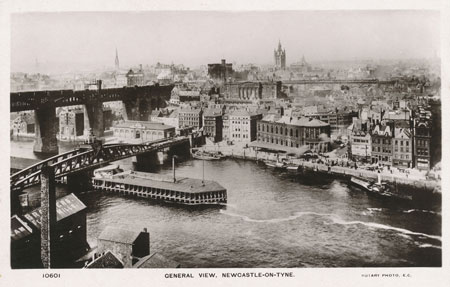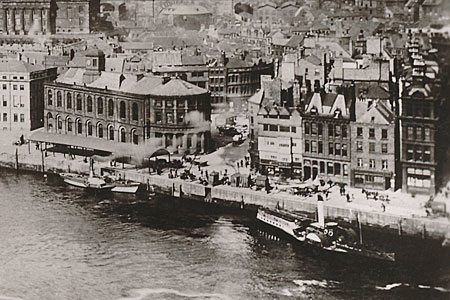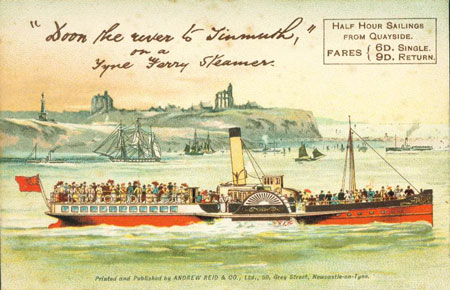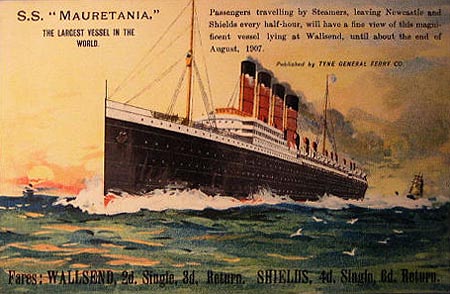|
Simplon - The Passenger Ship Website -
www.simplonpc.co.uk Simplon Home - www.simplonpc.co.uk - Simplon facebook - Recent Updates - Search Simplon - Copyright Information - Contact Simplon This website has no connection with any shipping company, cruise line, boat operator or other commercial organisation - There are no postcards for sale on this website |
||
|
Tyne Ferries |
||
|
This page shows postcards and images of the local
ferries on the River Tyne. The sole remaining route is the Shields Ferry
between South Shields (Market Place) and North Shields (North Quay). The
south terminal is situated just 5 minutes from South Shields Metro station.
the north terminal is a steep 10 minute walk to North shields Metro station,
but ferries are me by bus number 333 which is free for ferry passengers. For
more details see:
www.nexus.org.uk/ferry
Early Tyne Ferries Before the age of steam small sculler boat ferries crossed the Tyne at many locations. Above Newcastle on the section of river up to Scotswood (where a suspension bridge was built in 1832 followed by a railway bridge in 1839) there were ferries at Benwall (to the Delta Iron Works), Elswick High Ferry (to Armstrong's works), Elswick (Low) Ferry and the Redheugh Ferry. The number of ferries on the Mid-Tyne section between Newcastle and the sea increased as industry expanded along both banks. Minor ferries included the Ouseburn Ferry (to 1948), Mushroom Ferry (to 1900), St Peter's Ferry (to 1940), Felling Shore Ferry (to 1890), Heworth Shore Ferry (to 1900) and St Anthony's Ferry (to 1945). Those which survived into the Twentieth Century often converted to using motor boats. The Wincomblee Ferry (or Early Ferry) was operated by Edward Redhead and his son from Wincomblee Quay in the early 1800s. The site moved when William Dobson built his shipyard in 1883. The north bank became the Armstrong's walker Naval Yard in 1912, built to relieve the Elswick works. Battleships built here included HMS Malaya, HMS Nelson and HMS King George V. A sculler boat continued to run the ferry until WW2. Another sculler boat operated from Low Walker to Tyne View until 1948. Mid-Tyne Ferry - Hebburn to Wallsend & Walker The next ferry downstream was a route from Hebburn to Wallsend/Walker, started by Andrew Leslie in the 1850s to bring workers to his shipyard in Hebburn, initially from Wallsend, probably replacing an earlier sculler ferry. Andrew Leslie amalgamated with R&W Hawthorn before 1890 to form Hawthorn Leslie. They acquired two second hand steamers Hebburn and Wallsend in 1903. Wallsend had been built in 1890 for use on the Clyde. A second route to Walker started in 1910 for which two smaller boats Fairy Queen and Walker were bought. In 1938, Hawthorn Leslie pushed to have the ferry taken over by the local authorities. Because the the ferries were old and required replacement, they threatened to withdraw the services. They deferred the closure for three months by which time the war had started. From late 1939 the ferry was run by Mid-Tyne Ferries Ltd of Hebburn, jointly owned by shipbuilders Swan Hunter & Wigham Richardson, Hawthorn Leslie, and Vickers-Armstrong, plus electrical engineers A.Reyrolle. They soon ordered two new diesel ferries Mid-Tyne Nos 1 & Mid-Tyne No.2 delivered in 1940, replacing Fairy Queen and Walker, the latter being sold to become reserve ferry between Howden & Jarrow. Hebburn was sunk in 1940 after a collision with a tug. Mid-Tyne No 3 was delivered in 1949 to replace the Wallsend, the last of the original four ferries. The three new diesel boats were later renamed Tyne Queen, Tyne Princess and Tyne Duchess. They were used to run river cruises during the summer months. Usage of the ferries reduced as the shipbuilding industry declined. In 1968, ownership of Mid-Tyne ferries passed to the Swan Hunter Group. The Walker Naval Yard closed in 1985 and the ferry service ceased on July 25th the following year, the boats being sold for excursion use. Willington Quay/Howden to Jarrow Ferries There may have been a ford at Jarrow in Roman times. Subsequently sculler boats ran ferry services. Unverified reports state that two steamers Punch and Judy ran in 1852 for Charles Palmer who had opened his shipyard at Jarrow. In 1854 the underpowered Palmers-built Tom Tit had a brief life on the Jarrow ferry, and was probably the first steam ferry on the Tyne. Palmers built the 38ton Punch for the route in 1861, but she was sold to the Tyne General Ferry Company in 1863, who ran her until1883. The Shields Direct Ferry Company also started a vehicle (horse & cart) ferry between Willington Quay and Jarrow in the 1850s using the Tyne. This service was later run by the Tyne Improvement Commission. In 1883, Jarrow Corporation built the G.H.Dexter, followed by the C.M.Palmer in 1884, both capable of carrying horses and carts between Jarrow and Howden. In 1899, Jarrow Corporation sold the service to the Tyne General Ferry Company. This company failed in 1909, but the profitable Jarrow-Howden ferry was sold to Robert Frazier & Sons. The C.M.Palmer sank in 1916. Jarrow Corporation repurchased the ferry, with the G.H.Dexter, in 1919. She was replaced by the A.B.Gowan in 1921, which could carry five lorries and 300 passengers, or just 565 passengers. Passenger usage declined when the Tyne Pedestrian and Cyclist Tunnel opened in 1951. The Tyne Tunnel was opened on 19th October 1967 and A.B.Gowan finished service that day, making a final crossing on 4th November after which she was scrapped. Shields Ferries The earliest records of a ferry between North and South Shields are from 1377. In 1588 the Old Landing Ferry was running from the Coble Landing area of eastern South Shields. the North Shields landing was west of Cliffords Fort and later Clive Street. Most ferries were passenger only, but a 'horse boat' was ordered in 1588. There have been numerous proposals to bridge the Tyne near North & South Shields, but none came to anything. Following the failure of an 1826 bridge proposal, alternatives were sought. The Shields Ferry Act of 1829 established the North & South Shields Ferry Company, to convey passengers, carriages, horses, cattle and goods. Regular services began in July 1830 between market Street/New Quay in South Shields to Ferry Street/Market Place in North Shields, both close to the current pier locations. The first steamboat Baron Rewcastle proved to be inadequate, and a second vessel Durham (1), of unusual catamaran form with a single central paddle wheel, was possibly little better. A third boat Northumberland (1), replacing the Baron Rewcastle in 1830, proved to be unstable, but ran until 1883. Both Durham (1) and Northumberland (1) had a tendency to run aground. Competition arrived in 1847 when the Tyne Direct Ferry Company was formed, running the Percy between the New Quay to Kinton's Quay in North Shields. The Direct Ferry was known as the Ha'penny Dodger, from the fare charged and the way it dodged between other river traffic. Amalgamation of the two companies followed in 1949. A third service was run in from 1856 between Whitehill Pont and West Holborn using the steamer Favourite. The Tyne Improvement Commission was empowered by an act of Parliament to buy the Tyne ferries, and acquired the Shields Ferry for £39,000 in 1863. At this time the fleet was the horse & cart ferries Durham (1) and Northumberland on the Market Place ferry, and the Tyne on the Jarrow Ferry. Passenger vessel Percy ran the Direct Ferry and Favourite worked the Whitehill route. New ferries followed the takeover with the vehicle ferries Durham (2) in 1866, Tyne (2) in 1869 and Tynemouth (1) in 1883, all used on the Market Place ferry. New passenger ferries included the Shields (1868) and J.R.Proctor (1890) for the Whitehill Point route, plus the Collingwood (1) (1896) for the Direct Ferry. There was a failed scheme to build a transporter bridge in 1901, after which Tyne Improvement Commission promoted a Parliamentary Bill to enable it to improve the ferries. This was enacted in 1902 with the provision of two new, larger pontoons at North Shields, one serving the market Place ferry and the other for the Direct Ferry and Tyne General ferry Company's steamers (which provided services along the river). Similar improvements were made at the Market Place terminal. New ferries built were the passenger boats George Armstrong (1904) for the Direct Ferry, plus Thomas Richardson and U.A.Ritson in 1906 for the Market Place route. The new vehicle ferry South Shields was built for the Market Place route in 1911. She survived until 1968. Further new vehicle ferries were the Tynemouth (2) of 1925 and the Northumbrian in 1930. These vessels continued running the ferries for many years, despite increasing complaints about the service. A new Collingwood (2) was acquired in 1939, replacing the original Collingwood (1) on the Direct Ferry. The Whitehill Point service ceased in 1941 due to war damage. It was briefly reinstated on an experimental basis in 1951 using the steam launch Osmia, but ceased permanently the following year once Parliamentary permission had been obtained. The next ferry to close was the Direct route in 1954, the Collingwood (2) being sold for conversion into a yacht. The Market Place ferry was still busy, carrying around 400,000 vehicles a year. This traffic almost disappeared as soon as the Tyne Tunnel was built in 1967. The 1911 South Shields was withdrawn in March 1968 and broken up, followed in April by the 1925 Tynemouth (2) . Northumbrian continued alone until the arrival of the first modern ferry in 1972. Modern passenger ferries used have been the Freda Cunningham (1972-1994), Shieldsman (1976-2008), Pride of the Tyne (1993), and Spirit of the Tyne (2007), the latter two maintaining the service in 2011. |
||




